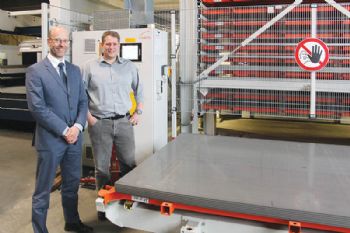
Sheet metal sub-contractor Keller Blechtechnik — based in Endingen, southern Germany — has increased its productivity by more than 25%, thanks to its on-going investment in the automated storage, retrieval and handling of sheet material.
Furthermore, the availability of this material has improved, and scrap has been reduced drastically.
The firm, which employs over 40 people, was started as a forge and blacksmith’s workshop in 1901 by the great-grandfather of the current managing partner, Harald Keller.
He joined the company in 2001 and has overseen rapid progress in the supply of sheet-metal parts and assemblies to customers in a broad range of industries; these include automotive, food production, medical, pharmaceutical, agricultural, solar power and general mechanical engineering.
Having such an extensive customer base means that Keller is continually presented with challenges, such is the wide range of different materials that need to be supplied.
Previously, material was stored at several locations, which made planning, transport and handling time-consuming; today, the situation is very different. With the help of sawing and materials-handling specialist Kasto (
www.kasto.com), Keller built a made-to-measure storage and material-flow system.
It is based on a Kasto Unitower B 3.0 computer-controlled sheet-metal storage system with 89 pallet storage locations, which is linked to a laser profiling machine.
The pallets hold 3,000 x 1,500mm sheets and can accommodate a 90mm-high stack of different sheet types; at Keller, these are mainly steel, stainless steel and aluminium in thicknesses ranging from 0.5 to 20mm.
Each location has a load capacity of 3 tonnes, so around 270 tonnes of sheet metal are available for immediate delivery.

The storage system offers a high level of availability, so Keller can react quickly to customer needs and priorities. It transfers pallets to and from storage and supplies sheets directly to the laser cutting cell, which has one station with a transverse carriage and one with a longitudinal carriage (to allow unpacked sheet to be loaded and unloaded by fork-lift truck or crane, the transverse carriage is equipped with a hydraulic lifter).
The longitudinal carriage has a drop-off position for the transfer of system pallets to and from storage — and the return of pallets that are no longer needed during laser cutting. Both stations and carriages have an optical contour monitor to ensure safe operation and prevent malfunctions.
The gantry crane that undertakes pallet- and sheet-handling operates at a maximum speed of 22m/min in the vertical direction; the pallet push/pull speed is 20m/min.
Meanwhile, Kasto’s EasyControl software system can be operated automatically or manually; it also handles order management for the complete storage system. Furthermore, an interface to the laser cutting machine’s loading system
ensures smooth material transfer.
Describing the system installed at Keller, Martin Stöckle — sales team leader at Kasto — says: “By using the standard versions of the Unitower B 3.0 sheet-storage tower but adapting the arrangement of the transverse and longitudinal stations, we were able to design a very compact system.
Because the space available was limited due to the layout of the laser cutting cell and other equipment, we suggested installing the tower store behind an existing wall to transport the pallets to the loading-system area by the shortest-possible route.
“This minimises delivery times, allowing the laser cutting machine to be operated almost continuously during the 1.5-manned shifts and then unattended for the remainder of the 24 hours.
Overall, a significant increase in productivity of around 25% has been achieved, compared with previous material-storage practices. In addition, the ability to keep track of the material inventory has enabled us to optimise stock levels and reduce scrap.”
In conclusion, Mr Keller said: “As well as increasing productivity by a quarter, the risk of material damage caused by frequent handling and transportation has been minimised.
“Furthermore, working conditions for our staff are safer and more convenient. We have also improved the utilisation of the laser cutting system, thanks to shorter idle times — and we have eliminated transport from external storage locations and hence the need for weather protection.
“We now have a compact and cost-effective ‘3-D storage solution’ for a wider range of materials and therefore better availability to respond quickly to customer requirements.”